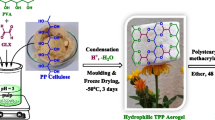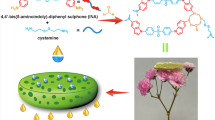Abstract
Problems from water contamination of oil and organic solvents have become more serious in recent years. We report research describing the fabrication of a hydrophobic sponge aerogel from pomelo peel for oil/water separation. Hydrophobic pomelo peel sponge aerogel (HPSA-1) was synthesized via dispersion, freeze-drying, and chemical vapor deposition (salinization) with hexadecyltrimethoxysilane. The morphology and chemical properties of the sponge aerogels were analyzed by scanning electron microscope and Fourier transform infrared. HPSA-1 was examined for use to remove some oils and organic solvents floating on water. HPSA-1 aerogels had medium absorption capacity; however, removal ability and the absorption of HPSA-1 were saturated at exposure times of 10 s. Diesel oil was the highest absorbate with absorption capacity (3.08–3.64 g g−1) and recovery percent of 48.15–59.46%. Removal abilities of selected oils and organic solvents floating on water using HPSA-1 at 10 s were investigated. HPSA-1 absorbed the oils and organic solvents in the range of 1.98–3.85 g g−1, with absorption levels depending on their types. Of the oils tested, palm oil had the highest absorption level with HPSA-1 removal at 3.85 g g−1 and 57.5%, respectively.






Similar content being viewed by others
Data Availability
All data generated and analyzed during this study are included in this published article.
References
Chai, W., Liu, X., Zou, J., Zhang, X., Li, B., & Yin, T. (2015). Pomelo peel modified with acetic anhydride and styrene as new sorbents for removal of oil pollution. Carbohydrate Polymers, 132, 245–251.
Cheng, Q., Ye, D., Chang, C., & Zhang, L. (2017). Facile fabrication of superhydrophilic membranes consisted of fibrous tunicate cellulose nanocrystals for highly efficient oil/water separation. Journal of Membrane Science, 525, 1–8.
Feng, J., Nguyen, S. T., Fan, Z., & Duong, H. M. (2015). Advanced fabrication and oil absorption properties of super-hydrophobic recycled cellulose aerogels. Chemical Engineering Journal, 270, 168–175.
Foo, K. Y., & Hameed, B. H. (2011). Microwave assisted preparation of activated carbon from pomelo skin for the removal of anionic and cationic dyes. Chemical Engineering Journal, 173, 385–390.
Gupta, R., Dunderdale, G., England, M., & Hozumi, A. (2017). Oil/water separation techniques: A review of recent progresses and future directions. Journal of Materials Chemistry A, 5, 16025–16058.
Jiang, F., & Hsieh, Y.-L. (2014). Amphiphilic superabsorbent cellulose nanofibril aerogels. Journal of Materials Chemistry A, 2, 6337–6342.
Jin, C., Han, S., Li, J., & Sun, Q. (2015). Fabrication of cellulose-based aerogels from waste newspaper without any pretreatment and their use for absorbents. Carbohydrate Polymers, 123, 150–156.
Karatum, O., Steiner, S. A., Griffin, J. S., Shi, W., & Plata, D. L. (2016). Flexible, mechanically durable aerogel composites for oil capture and recovery. ACS Applied Materials & Interfaces, 8, 215–224.
Khanjanzadeh, H., Behrooz, R., Bahramifar, N., Gindl-Altmutter, W., Bacher, M., Edler, M., & Griesser, T. (2018). Surface chemical functionalization of cellulose nanocrystals 3-aminopropyltriethoxysilane. International Journal of Biological Macromolecules, 106, 1288–1296.
Khosravi, M., & Azizian, S. (2015). Synthesis of a novel highly oleophilic and highly hydrophobic sponge for rapid oil spill cleanup. ACS Applied Materials & Interfaces, 7, 25326–25333.
Li, H., Sun, Z., Zhang, L., Tian, Y., Cui, G., & Yan, S. (2016). A cost-effective porous carbon derived from pomelo peel for the removal of methyl orange from aqueous solution. Colloids and Surfaces A, 489, 191–199.
Lin, Q., Mendelssohn, I. A., Carney, K., Miles, S. M., Bryner, N. P., & Walton, W. D. (2005). In situ burning of oil in coastal marshes. 2. Oil spill cleanup efficiency as a function of oil type, marsh type, and water depth. Environmental Science & Technology, 39, 1855–1860.
Lv, E., Xia, W., Tang, M., & Pu, Y. (2017). Preparation of an efficient oil-spill adsorbent based on wheat straw. BioResources, 12, 296–315.
Maleki, H. (2016). Recent advances in aerogels for environmental remediation applications: A review. Chemical Engineering Journal, 300, 98–118.Meng L., Bao M., Sun P. 2018. Construction of long-chain alkane degrading bacteria and its application in bioremediation of crude oil pollution. International Journal of Biological Macromolecules, 119, 524–532.
Nguyen, S. T., Feng, J., Le, N. T., Hoang, N., Tan, V. B. C., & Duong, H. M. (2013). Cellulose aerogel from paper waste for crude oil spill cleaning. Industrial & Engineering Chemistry Research, 52(51), 18386–18391.
Rafieian, F., Hosseini, M., Jonoobi, M., & Yu, Q. (2018). Development of hydrophobic nanocellulose-based aerogel via chemical vapor deposition for oil separation for water treatment. Cellulose, 25, 4695–4710.
Shi, G., Qian, Y., Tan, F., Cai, W., Li, Y., & Cao, Y. (2019). Controllable synthesis of pomelo peel-based aerogel and its application in adsorption of oil/organic pollutants. Royal Society Open Science, 6, 181823.
Wang, Y., Zhu, L., Zhu, F., You, L., Shen, X., & Li, S. (2017). Removal of organic solvents/oils using carbon aerogels derived from waste durian shell. Journal of the Taiwan Institute of Chemical Engineers, 78, 351–358.
Zhu, L., Wang, Y., Wang, Y., You, L., Shen, X., & Li, S. (2017). An environmentally friendly carbon aerogels derived from waste pomelo peels for the removal of organic pollutants/oils. Microporous and Mesoporous Materials, 241, 285–292.
Acknowledgements
We would like to appreciatively thank to Prof. Guy R. Lanza, State University of New York for editing in English.
Funding
The authors received financial support by Chemistry Department, Faculty of Liberal Arts and Science, Kamphaeng Sean campus, Kasetsart University, Nakhon Pathom province, Thailand.
Author information
Authors and Affiliations
Corresponding author
Ethics declarations
Conflict of Interest
The authors declare no competing interests.
Additional information
Publisher's Note
Springer Nature remains neutral with regard to jurisdictional claims in published maps and institutional affiliations.
Rights and permissions
About this article
Cite this article
Pung, T., Ponglong, N. & Panich-pat, T. Fabrication of Pomelo-Peel Sponge Aerogel Modified with Hexadecyltrimethoxysilane for the Removal of Oils/Organic Solvents. Water Air Soil Pollut 233, 283 (2022). https://doi.org/10.1007/s11270-022-05766-8
Received:
Accepted:
Published:
DOI: https://doi.org/10.1007/s11270-022-05766-8




